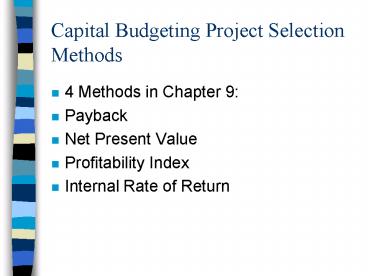Capital Budgeting Project Selection Methods PowerPoint PPT Presentation
1 / 14
Title: Capital Budgeting Project Selection Methods
1
Capital Budgeting Project Selection Methods
- 4 Methods in Chapter 9
- Payback
- Net Present Value
- Profitability Index
- Internal Rate of Return
2
Characteristics of a Good Project Selection Method
- Considers all project cash flows (from NICO
through DCF) - Adjusts cash flows for timing (finds PV
of future cash flows) - Incorporates firms cost of capital (uses MCC
in analysis)
3
Payback Method
- Determine how long ( years) it takes to recover
NICO from OCFs - Compare payback period to company determined
standard - No universal guidelines
- Payback method fails to meet any of the criteria
for good selection method
4
Net Present Value
- Find the PV of the OCFs and the DCF using the
firms MCC - Subtract NICO from the sum of the PVs
- Result is NPV
- If NPV gt 0, accept project
- If NPV lt 0, reject project
5
Profitability Index
- Find the PV of the OCFs and the DCF using the
firms MCC - Divide the sum of the PVs by NICO
- Result is PI
- If PI gt 1.0, accept project
- If PI lt 1.0, reject project
6
Internal Rate of Return
- Solving for unknown interest rate
- Looking for rate that makes the PV of the OCFs
and the DCF equal to NICO - If IRR gt MCC, accept project
- If IRR lt MCC, reject project
7
Incorporating Risk into the Capital Budgeting
Process
- What can go wrong with incremental cash flow
estimates? - NICO can be larger than expected
- OCFs and DCF can be smaller than expected
- Useful life can be shorter than expected
8
Options for Incorporating Risk
- Scenario Analysis
- Sensitivity Analysis
- Risk Adjusted Discount Rates
9
Scenario Analysis
- Set up different scenarios for the projects cash
flows - Best Case Lowest NICO, Highest OCFs and DCF,
longest life - Worst Case Highest NICO, Lowest OCFs and DCF,
shortest life - Most Likely Case Cash flows fall in between Best
and Worst Cases
10
Sensitivity Analysis
- What if analysis
- Change one variable by a certain . Hold other
variables constant. Recalculate NPV, PI, or IRR.
Look at change in NPV, PI, or IRR. - Identifies which variables have biggest impact on
success/failure of project
11
Risk Adjusted Discount Rates (RADR)
- Average risk projects should be evaluated using
MCC - Average risk means projects similar to what
company has done in the past - MCC represents investors required rates of
return based on what the firm currently does
12
Above Average Risk Projects
- When firm undertakes new kind of work, investors
want higher rates of return to compensate for
increased risk - Use MCC extra points for projects that are
different from what firm usually does
13
Purpose of RADR
- The higher the risk of a project, the higher the
discount rate used to evaluate the project - The higher the discount rate, the lower the PV of
future cash flows - The lower the PV, the harder it will be to cover
NICO - Higher risk projects have to meet a tougher
standard
14
Example of RADR
- Risk Class 1 Replacement projects. Use MCC.
- Risk Class 2 Expansion projects. Use MCC 3
points. - Risk Class 3 New projects. Use MCC
5 points.

